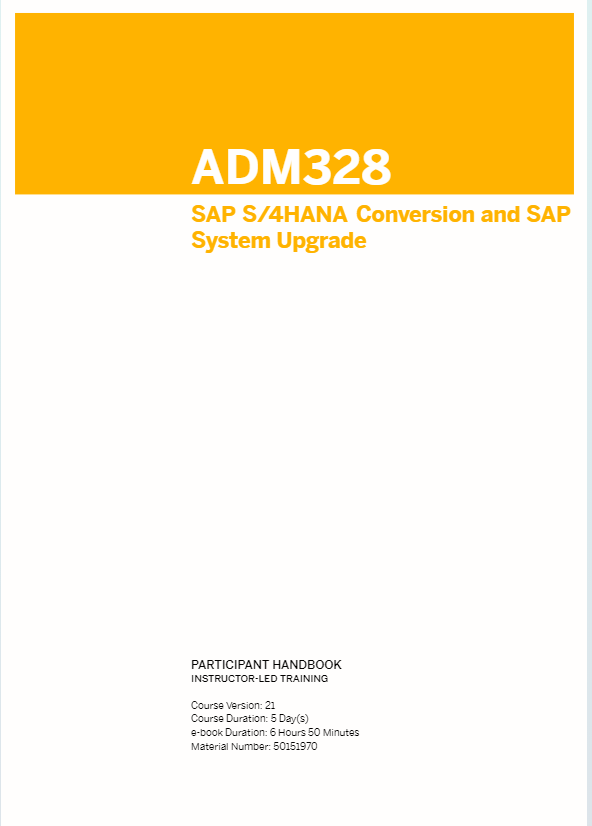SAP升级, S4hana conversion,升级考试,真实考题
Technology Specialist - SAP S/4HANA Conversion and SAP System Upgrade 2020

E_S4HCON2020, E_S4HCON2019
升级考试例题
SAP S/4HANA Conversion and SAP System Upgrade Sample Questions:
01. During an SAP S/4HANA conversion with DMO, which of the following actions take place during the business downtime of the SUM procedure?
There are 3 correct answers to this question.
a) Execution of SPAU modification adjustment
b) Execution of eCATTs for business validation tests
c) Creation of the table structures in the new SAP HANA database
d) Execution of SPDD modification adjustment
e) Execution of XPRAs and AIMs
02. Which maintenance events are possible with SUM for an SAP system based on AS ABAP 7.40 and above?
There are 3 correct answers to this question.
a) Support Package Stack update
b) Homogenous system copy
c) Release upgrade
d) Dual Stack split
e) Database migration
03. What do you do to prepare the database migration option of a SUM procedure?
There are 3 correct answers to this question.
a) Extract the SAP HANA database installation archive
b) Move the stack.xml update file into the download folder
c) Extract the SAP HANA client installation archive
d) Move the SPAM update archive into the download folder
e) Move the R3trans update archive into the download folder
04. In which part of an upgrade does SUM allow you to generate ABAP loads (SGEN)?
There are 2 correct answers to this question.
a) During downtime
b) During SPDD
c) Post-downtime
d) During uptime
05. You are planning to upgrade your SAP ECC 6.07 system running on a single codepage (SCP) to SAP ECC 6.08.
What is the recommended option to perform this upgrade?
Please choose the correct answer.
a) Perform the upgrade to SAP ECC 6.08 before the Unicode conversion.
b) Combine the upgrade and the Unicode conversion using the Twin Upgrade & Unicode Conversion (TU & UC) procedure.
c) Perform the Unicode conversion before the upgrade to SAP ECC 6.08.
d) Combine the upgrade and the Unicode conversion using the Combined Upgrade & Unicode Conversion (CU & UC) procedure.
06. The SUM procedure stops with an error during uptime. How can you identify the current phase, the one in which SUM encountered an error?
There are 2 correct answers to this question.
a) Check the most recent entries shown in file sapevt.trc
b) Check the system log (transaction SM21) of the SAP system
c) Check the messages shown by the SUM UI
d) Check the most recent entries in SAPup.log
07. During a DMO procedure with SUM, after which phase is the repository first available on the target database?
Please choose the correct answer.
a) Uptime migration (EU_CLONE_MIG_UT_RUN)
b) Parallel distribution (PARDIST_SHD)
c) Downtime migration (EU_CLONE_MIG_DT_RUN)
d) Shadow repository creation (EU_IMPORT*)
08. What can you achieve by setting the SUM parameter "migration_only" to 1 in parameter file SAPup_add.par?
Please choose the correct answer.
a) An upgrade of the software components is performed, without changing the database type.
b) A change of the database type is performed, without changing the software components.
c) An SAP S/4HANA conversion is performed, without adapting the customer data.
d) A migration of the SAP system to a new hardware is performed, without performing an SAP S/4HANA conversion.
09. You are performing an SAP S/4HANA conversion of the development system. Which credentials do you use in which system to perform the adjustment of programs and other non-dictionary repository objects (SPAU)?
Please choose the correct answer.
a) Credentials of a named user in client 000 of the shadow system
b) Credentials of a named user in the development client of the development system
c) Credentials of user DDIC in client 000 of the shadow system
d) Credentials of user DDIC in the development client of the development system
10. Which additional configuration options are offered by SUM when selecting "Switch expert mode on" in main configuration option "Standard"?
There are 2 correct answers to this question.
a) Keep archiving on during the whole procedure.
b) Use the Near Zero Downtime Maintenance Technology (NZDM).
c) Reuse a profile for the shadow instance from a previous run.
d) Choose the instance number of the shadow instance.
| QUESTION: 01 Answer: a, b, e | QUESTION: 02 Answer: a, c, e | QUESTION: 03 Answer: b, c, d | QUESTION: 04 Answer: c, d | QUESTION: 05 Answer: c |
| QUESTION: 06 Answer: c, d | QUESTION: 07 Answer: a | QUESTION: 08 Answer: b | QUESTION: 09 Answer: b | QUESTION: 10 Answer: c, d |